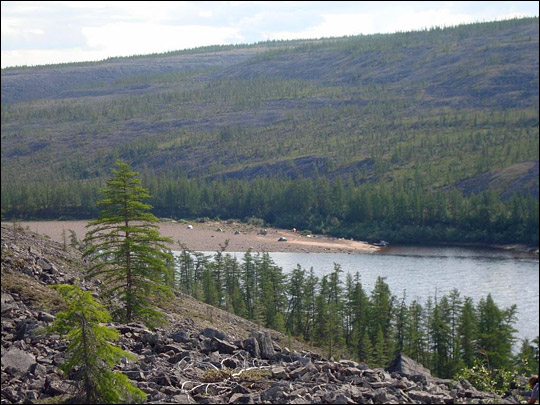

|
|
|||
July 15From Taymyrskiy Region, Siberia 9:30 PM USZ6S (9:30 AM EDT)
From Dr. RansonIt was an interesting day here. The morning started bright and beautiful, with no rain, no clouds. I went out with the Guoqing, Paul, and Ross to take measurements of the GLAS footprints nearby, which were across the river and on a mountain. The mountain is typical for the region: the elevation gain isn’t huge, but the slope is fairly steep. These mountains, called the Siberian Traps, have flattened tops and are made of basalt. They were created from the eruption of volcanoes in the area about 250 million years ago. That timing coincides with the Permian extinction, when many forms of life died out. The basaltic flows at that time were huge. Some estimate they may have covered up one to four million square miles. It must have been a world-changing event. It certainly changed this part of Siberia, leaving these magnificent mountains behind. [The Permian-Triassic Extinction was the worst mass extinction in Earth’s history. Fossils suggest that between 90-96 percent of all marine species and 70 percent of all land species died out.] |
|||

|
|||
|
There were several GLAS lines along the mountainside. We made a lot of measurements in the morning. The larch trees were all less than 10 meters tall. We actually saw a few willows, but none big enough to meet the criteria for measurements: they were so small they could be defined as “shrubs,” not trees. After this successful start, we found a nice lunch spot near a cliff. We enjoyed the view as we ate our lunch of canned fish and crackers. We were in a great mood and enthusiastic for the rest of the day’s work. As we made our first afternoon measurements, the sky darkened and a sudden thunderstorm moved in. So there we were, at the top of this mountain with thunder and lightening all around us. And the rain pouring down. What could we do? We just kept working. Unfortunately, our inclinometer—an instrument used to measure height— fogged up from all the moisture and became unreadable. We continued to make the diameter measurements, anyway. We’ll be able to go back and calculate the heights later, so all is not completely lost, but we’d much prefer to have been able to make the actual measurements today. Right now our inclinometer is drying out. I expect by the time we make the next camp it will be as good as new. Today the Russian team climbed another mountain, equally as steep as ours. There they took measurements and made observations for the study of the effects of elevation on tree growth. I had hoped that Slava would be available today to explain their work, but they are just now arriving back in camp. They have had a long day. Hopefully we’ll get him to discuss those studies in the days to come. I should mention something we’ve seen here that is pretty interesting. The Russians call it a “tree in a skirt.” And, with just a little imagination, that’s what it looks like. I’ll send a picture along, because it’s hard to describe. Basically, the top of the tree is the typical sparse-needled shape of the larch as it grows in this extremely harsh climate. Then, lower down, is a lush green growth. The branches are so heavy with needles that they sag down towards the ground. So it looks like a thin woman wearing a heavy green skirt. |
A view of the campsite taken from across the Kotuykan River. In the background are the flat-topped mountains known as the Siberian Traps. The slope in the foreground is littered with basaltic rocks formed from lava flows about 250 million years ago. The campsite was originally set up next to the riverbank. It is now on high ground; the river dropped about 2 meters overnight. (Photograph by Jon Ranson.) |
||

This happens because of the winter weather. When it snows, the bottom of the tree is covered up. This blanket of snow is actually very protective, keeping the lower branches safe. The part of the tree that sticks out of the snow is unprotected, so it is buffeted by the winds, which carry ice-crystals that can act like knives as they slice past the tree all winter long. It makes for an interesting-looking tree in summer! And also speaks to how incredibly harsh it is here in the winter time. Our summer weather is fabulous, compared to that. It is just very changeable. When it is raining, it is chilly. When it is sunny, then it feels very hot, especially since we have to wear the bug suits and carry gear along with us. It just is very hard to predict, so we take what comes. This campsite is beautiful tonight. The rains have cleared now. We can see downstream, where the river flows between more mountains. There is a fog rising up from the river between those mountains. A wonderful sight. It also feels really nice, when you are tired, chilled, and soaking wet, to come back to camp and warm up by the fire. Yes, we are sleeping on rocks again, but I doubt any of us will complain much—we’re tired and should sleep well. |
A photograph of a tree near the campsite shows a growth pattern that Siberians call a “tree in a skirt.” During Siberian winters, the bottom parts of trees can be covered by snow, which protects the branches from damaging winds. (Photograph by Jon Ranson.) |
||